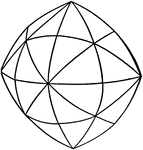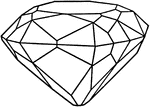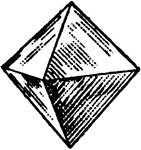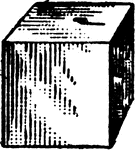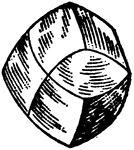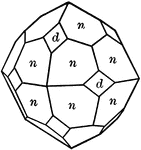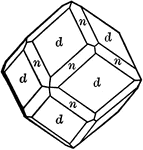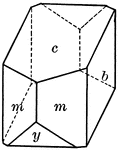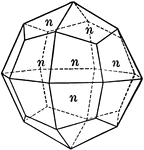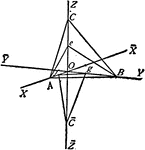
Crystallographic Axes of Reference
"...take any three edges formed by the intersection of three faces of a crystal. These axes are called…
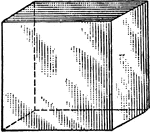
Cube
"Science has succeeded in classifying the thousands of known crystals in six systems, to each of which…
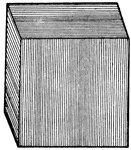
Cube of Iron Pyrite
Cubes of Iron Pyrites frequently show a striation of their planes in one direction, which is perpendicular…
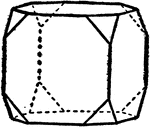
Cube in Combination with Octahedron
Represents the combination of an octrahedron and a cube, with the cube faces predominate.
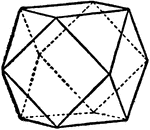
Cubo-octahedron
Represents the combination of a cube and an octahedron, with both faces being equal.
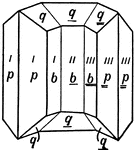
Cyclic Twinning
This crystal of Aragonite shows a method of twinning where the twinning plane may change its direction,…
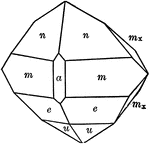
Datolite
"Monoclinic. Habit varied. Crystals usually nearly equidimensional in the three axial directions and…
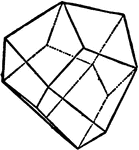
Deltoid Dodecahedron
"This is the hemihedral form of the triakis-octahedron; it has the indices {hhk} and is bounded by tweleve…

Diamond Cut
The diamond is cut to show the stone's brilliance, creating different parts to the cut: table, crown,…

Square Cut Diamonds
Various types of square cut diamonds. Top row: Old square cut diamonds. Bottom row: English square cut…

Dihexagonal Bipyramid
"...bounded by twenty-four scalene triangles...This form may be considered as a combination of two scalenohedra,…

Diopside
Diopside is a monoclinic pyroxene mineral with composition MgCaSi2O6. It forms complete solid solution…
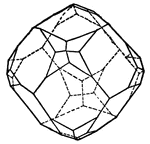
Dodecahedron
Crystal; This form is a combination of an icositetrahedron and a rhombic dodecahedron, where the faces…
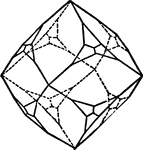
Dodecahedron
Crystal; This form is a combination of an icositetrahedron and a rhombic dodecahedron, where the faces…

Dolomite
"Hexagonal-rhombohedral. Crystals are usually the unit rhombohedron (cleavage rhombohedron). Faces often…
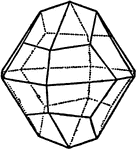
Dyakis-dodecahedron
"This is the hemihedral form of the hexakis-octahedron and has the indicies {hkl}; it is bounded by…

Enantimorphous Crystals of Tartaric Acid
"...shows two crystals of tartaric acid, a a right-handed crystal of dextro-tartaric acid, and b a left-handed…

Epidote
"Monoclinic. Crystals are often much elongated parallel to the ortho-axis with a prominent development…

First Right Square Octahedron
"Science has succeeded in classifying the thousands of known crystals in six systems, to each of which…

First Right Square Prism
"Science has succeeded in classifying the thousands of known crystals in six systems, to each of which…
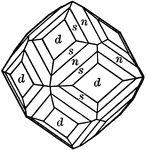
Garnet
"Isometric. Common forms dodecahedron amd trapezohedron, often in combination. Hexoctahedron observed…
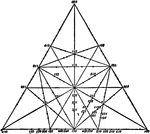
Gnomonic Projection of a Cubic Crystal
"Here the plane of projection is tangent to the sphere, and normals to all the faces are drawn fro mthe…

Gold
Gold crystals of the form 3O3, {311}, sometimes resemble combinations of the rhombohedron and scalenohedron.
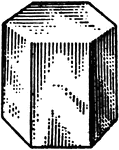
Graphite
"The second form of carbon, known as graphite, is a leaden-gray solid with a metallic luster and a specific…
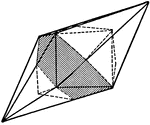
Green Fluorspar from Saxony
Certain crystals of green fluorspar from Saxony, showing the form ∞ 03, {310}, have one half of their…
Gypsum
"Monoclinic. Crystals usually tabular parallel to clinopinacoid; in diamond-shaped crystals with edges…
Gypsum
"Monoclinic. Crystals usually tabular parallel to clinopinacoid; in diamond-shaped crystals with edges…

Gypsum (Twinning)
This image represents a twin of the monoclinic mineral Gypsum. Its twinning plane is the orthopinacoid.

Hematite
"Hexagonal-rhombohedral. Crystals usually thick to thin tabular. Basal planes prominent, often showing…
Hematite
"Hexagonal-rhombohedral. Crystals usually thick to thin tabular. Basal planes prominent, often showing…
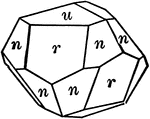
Hematite
"Hexagonal-rhombohedral. Crystals usually thick to thin tabular. Basal planes prominent, often showing…

Hemimorphism in the Direction of the Vertical Axis
Hemimorphism in the direction of the vertical axis has been observed on crystals of the tetragonal salt,…
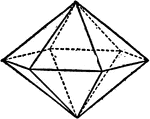
Hexagonal Bipyramid
"...bounded by twelve isosceles trianes each of which are equally inclined to two planes of symmetry."…
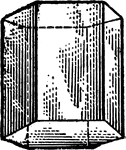
Hexagonal Prism
"Science has succeeded in classifying the thousands of known crystals in six systems, to each of which…
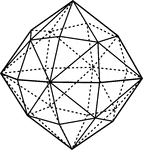
Hexakis-octahedron
"Here each face of the octahedron is replaced by six scalene triangles, so that altogether there are…
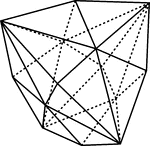
Hexakis-tetrahedron
"The hemihedral form {hkl} of the hexakis-octahedron; it is bounded by twenty-four scalene triangles…

Hexoctahedron
This form is bounded by forty-eight similar scalene triangles. Its solid angles are of three kinds:…
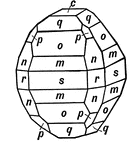
Hydrous Nickel Sulphate
This form shows the planes given on a crystal of hydrous nickel sulphate: the basal pinacoid, (c); three…

Hypersthene
This figure exhibits a combination occurring on the ferro-magnesian meta-silicate, Hypersthene. Forms:…
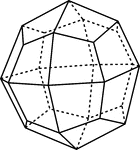
Icositetrahedron
"Bounded by twenty-four trapezoidal faces, and hence somethings called a 'trapezohedron.'" -The Encyclopedia…

Lead Tungstate
Also known as Stolzite, this crystal is bounded by the unit pyramid of the first order, P, {111} (o),…
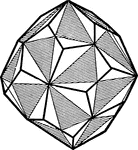
Lef-Handed Pentagonal Icositetrahedron
Crystal; If the alternate planes of the hexoctahedron extend until the intersect, a new for will result.…

Macro-prism and Brachy-pinacoid
"This consists of four faces parallel to the brachy axis." -The Encyclopedia Britannica 1910
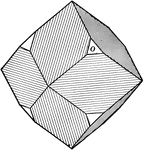
Magnetite
"Isometric. Octahedral habit, sometimes twinned octahedrons. Dodecahedron at times, either alone or…
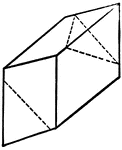
Magnetite
As shown on this crystal of Magnetite, the octohedron, by the crowding out of two of its opposite faces,…
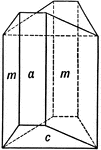
Malachite
The most common twinning plane is the orthopinacoid ∞P∞̄ , {100}, as may be seen in this example…

Glass manufacturing
"Five kinds of glass are made: flint glass, or crystal; crown glass, broad sheet glass, bottle, or green…

